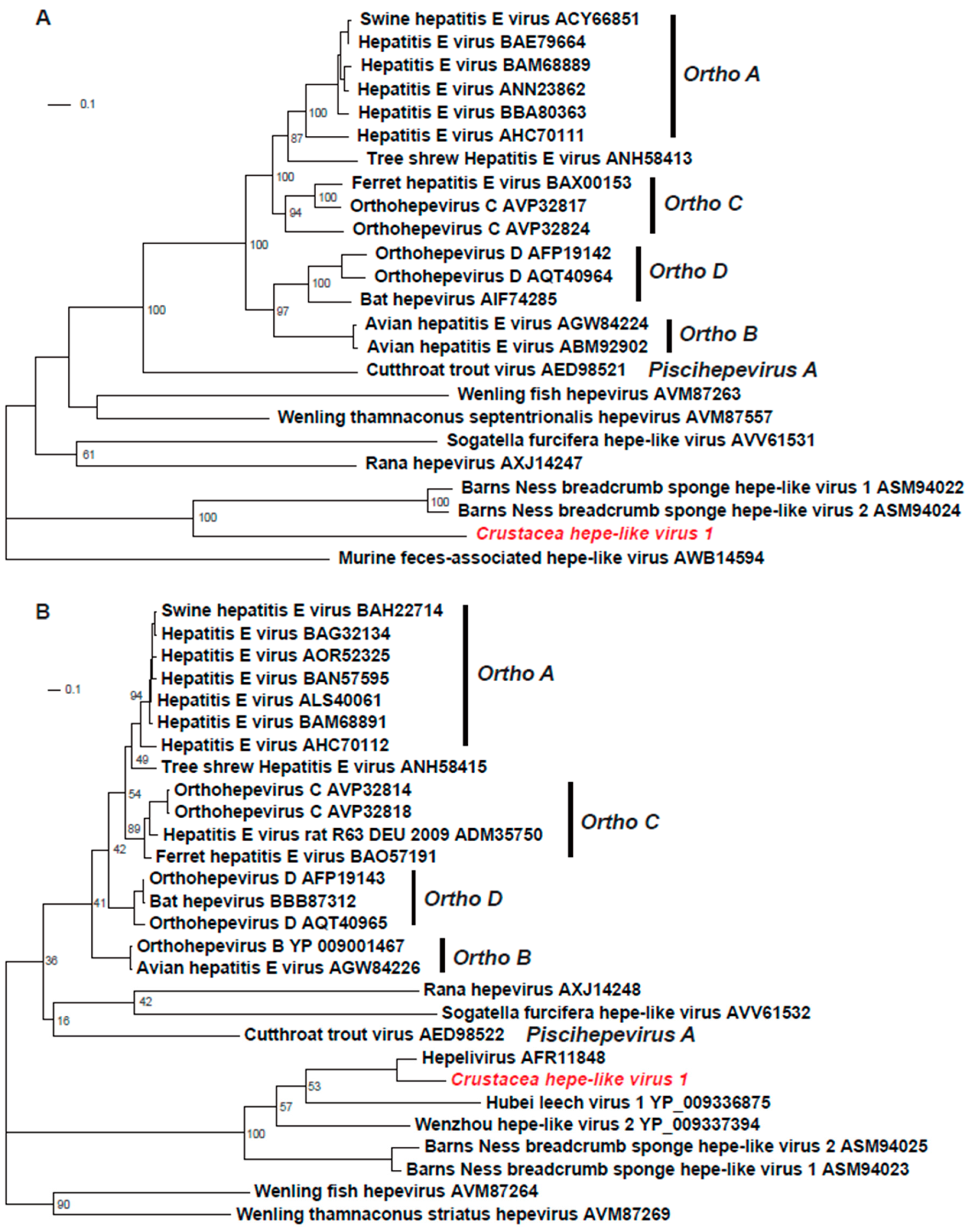A Novel Hepe-Like Virus from Farmed Giant Freshwater Prawn Macrobrachium rosenbergii
Abstract
1. Introduction
2. Materials and Methods
2.1. Sample Collection and Detection of Shrimp Pathogens
2.2. RNA Extract and Transcriptome Sequencing
2.3. Viral Genome Sequencing and Sequence Analysis
3. Results and Discussion
4. Conclusions
Supplementary Materials
Author Contributions
Funding
Acknowledgments
Conflicts of Interest
References
- Sooryanarain, H.; Meng, X.J. Hepatitis E virus: Reasons for emergence in humans. Curr. Opin. Virol. 2019, 34, 10–17. [Google Scholar] [CrossRef]
- Lara, J.; Purdy, M.A.; Khudyakov, Y.E. Genetic host specificity of hepatitis E virus. Infect. Genet. Evol. 2014, 24, 127–139. [Google Scholar] [CrossRef] [PubMed]
- Smith, D.B.; Simmonds, P. Classification and Genomic Diversity of Enterically Transmitted Hepatitis Viruses. Cold Spring Harb. Perspect. Med. 2018. [Google Scholar] [CrossRef] [PubMed]
- Smith, D.B.; Purdy, M.A.; Simmonds, P. Genetic variability and the classification of hepatitis E virus. J. Virol. 2013, 87, 4161–4169. [Google Scholar] [CrossRef] [PubMed]
- Smith, D.B.; Simmonds, P.; Jameel, S.; Emerson, S.U.; Harrison, T.J.; Meng, X.J.; Okamoto, H.; Van der Poel, W.H.; Purdy, M.A. Consensus Proposals for Classification of the Family Hepeviridae. J. Gen. Virol. 2014, 95, 2223. [Google Scholar] [CrossRef] [PubMed]
- Oliveira-Filho, E.F.; Konig, M.; Thiel, H.J. Genetic variability of HEV isolates: Inconsistencies of current classification. Vet. Microbiol. 2013, 165, 148–154. [Google Scholar] [CrossRef] [PubMed]
- Pavio, N.; Meng, X.J.; Doceul, V. Zoonotic origin of hepatitis E. Curr. Opin. Virol. 2015, 10, 34–41. [Google Scholar] [CrossRef] [PubMed]
- Okamoto, H. Genetic variability and evolution of hepatitis E virus. Virus Res. 2007, 127, 216–228. [Google Scholar] [CrossRef] [PubMed]
- Chen, J.; Wang, W.; Wang, X.; Zhang, Q.; Ren, Y.; Song, J.; Wang, X.; Dong, X.; Huang, J. First detection of yellow head virus genotype 3 (YHV-3) in cultured Penaeus monodon, mainland China. J. Fish Dis. 2018, 41, 1449–1451. [Google Scholar] [CrossRef] [PubMed]
- OIE. Manual of Diagnostic Tests for Aquatic Animals; The World Organisation for Animal Health (OIE): Paris, France, 2018. [Google Scholar]
- Qiu, L.; Chen, M.M.; Wan, X.Y.; Li, C.; Zhang, Q.L.; Wang, R.Y.; Cheng, D.Y.; Dong, X.; Yang, B.; Wang, X.H.; et al. Characterization of a new member of Iridoviridae, Shrimp hemocyte iridescent virus (SHIV), found in white leg shrimp (Litopenaeus vannamei). Sci. Rep. 2017, 7, 11834. [Google Scholar] [CrossRef] [PubMed]
- Bolger, A.M.; Lohse, M.; Usadel, B. Trimmomatic: A flexible trimmer for Illumina sequence data. Bioinformatics 2014, 30, 2114–2120. [Google Scholar] [CrossRef] [PubMed]
- Grabherr, M.G.; Haas, B.J.; Yassour, M.; Levin, J.Z.; Thompson, D.A.; Amit, I.; Adiconis, X.; Fan, L.; Raychowdhury, R.; Zeng, Q.; et al. Full-length transcriptome assembly from RNA-Seq data without a reference genome. Nat. Biotechnol. 2011, 29, 644–652. [Google Scholar] [CrossRef] [PubMed]
- Nakamura, T.; Yamada, K.D.; Tomii, K.; Katoh, K. Parallelization of MAFFT for large-scale multiple sequence alignments. Bioinformatics 2018, 34, 2490–2492. [Google Scholar] [CrossRef] [PubMed]
- Capella-Gutierrez, S.; Silla-Martinez, J.M.; Gabaldon, T. trimAl: A tool for automated alignment trimming in large-scale phylogenetic analyses. Bioinformatics 2009, 25, 1972–1973. [Google Scholar] [CrossRef] [PubMed]
- Stamatakis, A. RAxML version 8: A tool for phylogenetic analysis and post-analysis of large phylogenies. Bioinformatics 2014, 30, 1312–1313. [Google Scholar] [CrossRef] [PubMed]
- Ng, T.F.; Marine, R.; Wang, C.; Simmonds, P.; Kapusinszky, B.; Bodhidatta, L.; Oderinde, B.S.; Wommack, K.E.; Delwart, E. High variety of known and new RNA and DNA viruses of diverse origins in untreated sewage. J. Virol. 2012, 86, 12161–12175. [Google Scholar] [CrossRef] [PubMed]
- Smith, D.B.; Simmonds, P.; Izopet, J.; Oliveira-Filho, E.F.; Ulrich, R.G.; Johne, R.; Koenig, M.; Jameel, S.; Harrison, T.J.; Meng, X.J.; et al. Proposed reference sequences for hepatitis E virus subtypes. J. Gen. Virol. 2016, 97, 537–542. [Google Scholar] [CrossRef] [PubMed]
- Doceul, V.; Bagdassarian, E.; Demange, A.; Pavio, N. Zoonotic Hepatitis E Virus: Classification, Animal Reservoirs and Transmission Routes. Viruses 2016, 8, 270. [Google Scholar] [CrossRef] [PubMed]


| Primer | Sequence 5’-3’ |
|---|---|
| HE-1F | TGATAACGATGGATATTAATCCACAT |
| HE-1R | AGAAGTTGAAAATGCCGCTGAT |
| HE-2F | TCGTTTTCAAGAAAGGCAACAA |
| HE-2R | TAGAGGGAGCATGACTGGTTTGT |
| HE-3F | TTCACGTATGTCCAACACAATAACTA |
| HE-3R | GTGGGGTTGGTCTTATAGCGTA |
| HE-4F | ACTTCTTGGACATCCATTCCACA |
| HE-4R | GTGTAAAGATGTCTTACTTGCTCTGTT |
| HE-5F | GAAAACATCCACGCTCAAAATC |
| HE-5R | GGTTCATACCATTCTTTCTCCAGTT |
| HE-6F | CAAGCTAAGAAGCAATGCCGT |
| HE-6R | TTGTTCCAAGTCCTCAGGTGTGT |
| HE-7F | ATACATCTCCAACATTGTCACACCA |
| HE-7R | CTTTGAGTGCGTTGGCAATGT |
| HE-8F | GGAAAGCCTGGGACAGAGATA |
| HE-8R | ATTGCGATACTATGTAGGCCCA |
| 5’adaptor | GCTGTCAACGATACGCTACGTAACGGCATGACAGTGCCCCCCCCCCCCCCC |
| 3’adaptor | GCTGTCAACGATACGCTACGTAACGGCATGACAGTGTTTTTTTTTTTTTTTTTT |
| 5.3’outer | GCTGTCAACGATACGCTACGTAAC |
| 5.3’inner | GCTACGTAACGGCATGACAGTG |
| CHEV-H-F1 | CGTCCAGGAAAGGGCCAGTTAACAC |
| CHEV-H-F2 | CGATCAAAATCGATGGGGCCTAAAGT |
| CHEV-H-R2 | GCTGCAGATATTTGATCCCTGTGTCGTT |
| CHEV-H-R1 | ATTGGTCGACGATAAGTGGATCATTGTTCATA |
| CHEV-H-RT2 | TTGACTGCGTAAGCGTAA |
| CHEV-H-RT1 | GAGGTATTAGGTTGATGTCG |
© 2020 by the authors. Licensee MDPI, Basel, Switzerland. This article is an open access article distributed under the terms and conditions of the Creative Commons Attribution (CC BY) license (http://creativecommons.org/licenses/by/4.0/).
Share and Cite
Dong, X.; Hu, T.; Liu, Q.; Li, C.; Sun, Y.; Wang, Y.; Shi, W.; Zhao, Q.; Huang, J. A Novel Hepe-Like Virus from Farmed Giant Freshwater Prawn Macrobrachium rosenbergii. Viruses 2020, 12, 323. https://doi.org/10.3390/v12030323
Dong X, Hu T, Liu Q, Li C, Sun Y, Wang Y, Shi W, Zhao Q, Huang J. A Novel Hepe-Like Virus from Farmed Giant Freshwater Prawn Macrobrachium rosenbergii. Viruses. 2020; 12(3):323. https://doi.org/10.3390/v12030323
Chicago/Turabian StyleDong, Xuan, Tao Hu, Qingyuan Liu, Chen Li, Yani Sun, Yiting Wang, Weifeng Shi, Qin Zhao, and Jie Huang. 2020. "A Novel Hepe-Like Virus from Farmed Giant Freshwater Prawn Macrobrachium rosenbergii" Viruses 12, no. 3: 323. https://doi.org/10.3390/v12030323
APA StyleDong, X., Hu, T., Liu, Q., Li, C., Sun, Y., Wang, Y., Shi, W., Zhao, Q., & Huang, J. (2020). A Novel Hepe-Like Virus from Farmed Giant Freshwater Prawn Macrobrachium rosenbergii. Viruses, 12(3), 323. https://doi.org/10.3390/v12030323





